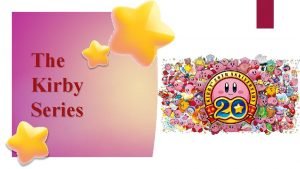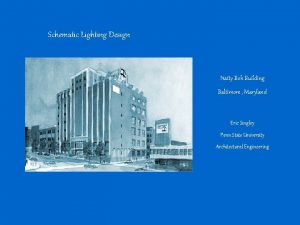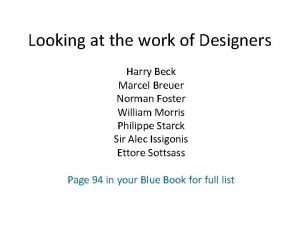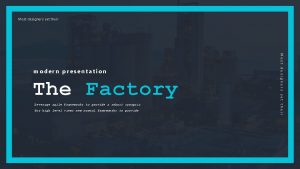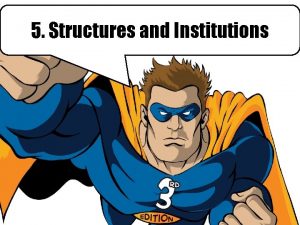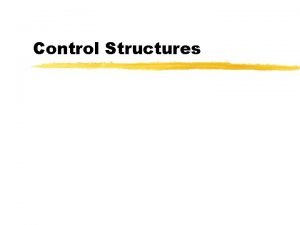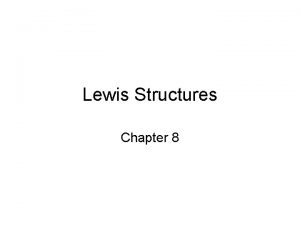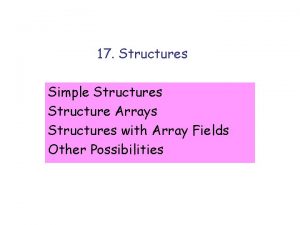Structures and Their Designers Meet the Designers Frank


















- Slides: 18

Structures and Their Designers

Meet the Designers

Frank Lloyd Wright's residential designs were "Prairie Houses" because the design is considered to complement the land around Chicago. These houses featured extended low buildings with shallow, sloping roofs, clean sky lines, suppressed chimneys, overhangs and terraces, using unfinished materials. The houses are credited with being the first examples of the “open plan. ” The manipulation of interior space in residential and public buildings are hallmarks of his style.

Greene & Greene Henry Charles The Greene’s took on few commercial projects. Their attention to detail would not have been possible in a larger firm, or one that focused on commercial buildings as well as residential. The Greene’s repeatedly turned down offers to construct buildings in downtown Los Angeles. The Greene brothers were masters in their area of domestic concentration for which, until the year of 1948, they received little acclaim. In 1948, they received citations from the Pasadena Chapter of the American Institute of Architects and from the national body in 1952 for creating a “new and native architecture. ”

Le Corbusier's early work was related to nature, but as his ideas matured, he developed the Maison-Domino, a basic building prototype for mass production with freestanding pillars and rigid floors. In 1917 he settled in Paris where he issued his book Vers une architecture [Towards a New Architecture], based on his earlier articles in L'Esprit Nouveau.

Antonio Gaudí During his youth, Gaudi suffered many times from the rheumatic fevers that were common at the time. This illness caused him to spend much time in isolation, and it allowed him to spend lots of time alone with nature. It was this exposure to nature at an early age, which is thought to have inspired him to incorporate natural shapes and themes into his later work. Gaudi, throughout his life, studied nature's angles and curves and incorporated them into his designs and mosaics. Instead of relying on geometric shapes, he mimicked the way men stand upright. The hyperboloids and paraboloids he borrowed from nature were easily reinforced by steel rods and allowed his designs to resemble elements from the environment.

Frank Gehry’s style at times seems unfinished or even crude, but his work is consistent with the California ‘funk’ art movement in the 1960 s and early 1970 s, which featured the use of inexpensive found objects and non-traditional media such as clay to make serious art. Gehry has been called "the apostle of chain-link fencing and corrugated metal siding".

I. M. Pei In terms of style, Pei's work at this time was strongly influenced by Mies van der Rohe. Certainly the apartment towers at Kips Bay and Society Hill owe much to Mies' earlier slab-like skyscrapers sheathed in glass grids. But unlike Mies, who supported his towers with frames of steel, Pei experimented with towers of pre-cast concrete window frames laid on one another like blocks. This system proved to be quick to construct and required no added fireproof lining or exterior sheathing, making it relatively inexpensive. The concrete frames also had the aesthetic advantage of looking "muscular" and permanent. Soon Pei acquired a reputation as a pragmatic, costconscious architect who understood the needs of developers and had the ability to produce solid-looking no-nonsense buildings.

Now it’s time to play the GAME!

The object of the game……. In front of you are eighteen photographs of structures and six photographs of the designers you just viewed… You need to match three structures to each designer by writing down the designer number, then under each designer, write down the number of the structure that you think they designed…. . Something like this

Who am I? Antonio Gaudí Casa Batallo Sagrada Familia Casa Mìla

Who am I? Frank Gehry Walt Disney Concert Hall, Los Angeles Dancing House, Prague Frank Gehry House, Santa Monica

Who are WE? Greene & Greene Gamble House, Pasadena Henry Charles Blacker House, Pasadena Thorsen House, Berkley

Who am I? I. M. Pei JFK Library Rock and Roll Hall of Fame Bank of China Tower

Who am I? Le Corbusier Centre Le Corbusier Notre Dame du Haute Villa Savoye

Who am I? Frank Lloyd Wright Robie House Falling Water Guggenheim Museum

How many did you get right? ?

1 2 3 4 5 6 5 3 1 7 10 2 Structure 9 13 6 8 14 4 Designer 11 15 18 17 16 12
 Peace be with you till we meet again
Peace be with you till we meet again Example of homologous structure
Example of homologous structure Frank william abagnale, jr.
Frank william abagnale, jr. The logical view of data is:
The logical view of data is: Famous italian designers
Famous italian designers Kirby series developers
Kirby series developers Lobby schematic
Lobby schematic Gameplay
Gameplay Scott phillips software developer
Scott phillips software developer Caltrans standard specifications 2015
Caltrans standard specifications 2015 Temporal key integrity protocol designers
Temporal key integrity protocol designers Harry beck work
Harry beck work Hugo boss (fashion designer)
Hugo boss (fashion designer) A systematic creative process for designers
A systematic creative process for designers Romeo + juliet prologue
Romeo + juliet prologue Hình ảnh bộ gõ cơ thể búng tay
Hình ảnh bộ gõ cơ thể búng tay Ng-html
Ng-html Bổ thể
Bổ thể Tỉ lệ cơ thể trẻ em
Tỉ lệ cơ thể trẻ em





